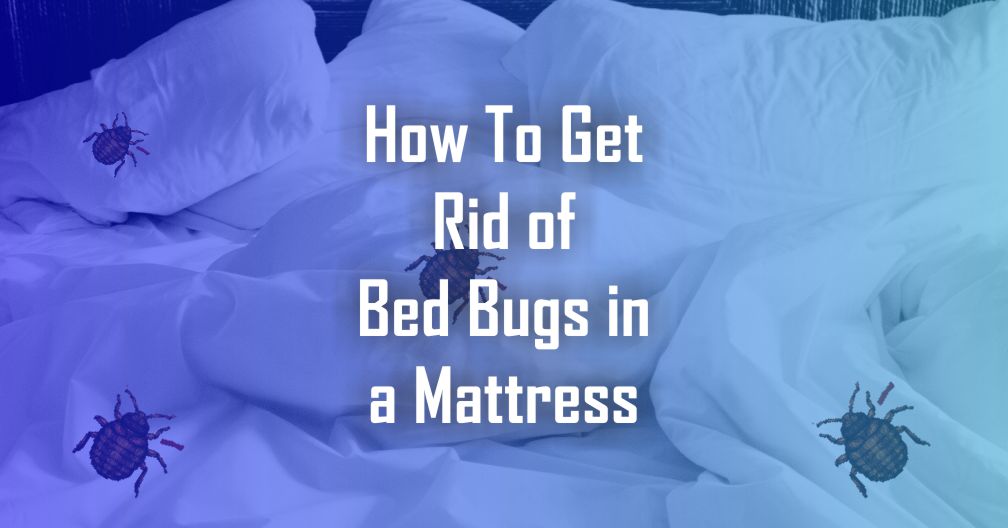Dealing with a bed bug infestation can be a frustrating and unnerving experience. These tiny, blood-sucking pests can quickly turn your comfortable haven into a nightmare.
Your mattress is among their favorite hiding spots, making it essential to address the issue promptly and effectively.
In this guide, we’ll explore step-by-step methods to help you get rid of bed bugs in a mattress, ensuring a peaceful night’s sleep again.
Steps to Get Rid of Bed Bugs in a Mattress
Bed bugs are small, nocturnal insects that feed on human blood. They can be challenging, but you can do a few things to eliminate bed bugs in your mattress.
Step 1: Wash your Bedding in Hot Water
Bed bugs cannot survive in temperatures above 120 degrees Fahrenheit. Soaking your bedding and clothing in hot water for at least 30 minutes will kill any bed bugs.
Step 2: Vacuum your Mattress
Bed bugs can hide in the seams and crevices of your mattress and box spring. Use a vacuum with a hose attachment to thoroughly vacuum your mattress and box spring. Be sure to pay attention to the seams, corners, and edges.
Step 3: Steam your Mattress
Steaming is another effective way to kill bed bugs. A steamer reaching at least 120 degrees Fahrenheit will kill bed bugs and their eggs. Be sure to steam all mattress surfaces, including the seams, corners, and edges.
Step 4: Use an Insecticide
You may need an insecticide if you have a severe bed bug infestation. Be sure to use an insecticide that is specifically labeled for bed bugs. Here are some typical insecticides that are used to get rid of bed bugs:
- Pyrethroids: Pyrethroid-based insecticides are widely used for bed bug control. They work by disrupting the nervous system of insects.
- Neonicotinoids: Neonicotinoid insecticides, such as imidacloprid and acetamiprid, target the nervous system of insects and are effective against bed bugs. These products are often used in combination with other treatments.
- Desiccants: Desiccant dust, like diatomaceous earth and silica gel, are natural substances that work by absorbing the waxy layer on a bed bug’s exoskeleton, causing it to dehydrate and die.
- Insect Growth Regulators (IGRs): IGRs, such as methoprene and pyriproxyfen, disrupt the development and reproduction of bed bugs. They prevent nymphs from maturing into adults and can significantly reduce the population.
- Biopesticides: Biopesticides are derived from natural sources, such as fungi, bacteria, and botanical extracts. Beauveria bassiana and Metarhizium anisopliae are fungal biopesticides that can infect and kill bed bugs.
- Professional-Grade Insecticides: Pest control professionals may use more potent insecticides that are not readily available to the general public. These may include products with active ingredients like chlorfenapyr and bifenthrin.
Step 5: Encase your Mattress
A bed bug mattress encasement is a tightly fitting cover that will prevent bed bugs from getting in or out of your mattress. This is an excellent way to protect your mattress from future infestations.
Step 6: Inspect your Home for Bed Bugs
Once you have treated your mattress, inspecting your home for other signs of bed bugs is essential. Look for bed bugs, eggs, or their droppings in other areas of your bedroom, such as your bed frame, headboard, nightstands, and dressers.
Step 7: Call a Pest Control Professional
If you have a severe bed bug infestation, you may want to call a pest control professional. They will have the knowledge and experience to get rid of bed bugs quickly and effectively.
It is important to note that bed bugs can be challenging to get rid of. It may take several weeks or even months of treatment to eliminate an infestation. Be patient and persistent, and you will eventually be able to get rid of bed bugs for good.
Conclusion
Getting rid of bed bugs in a mattress requires thorough cleaning, heat treatments, and preventive measures. While it can be time-consuming, following the steps outlined in this guide will help you reclaim your mattress and restore peace to your sleep environment.
Remember that early detection and consistent maintenance are crucial to preventing future infestations and ensuring a restful night’s sleep free from these unwanted pests.
If the infestation persists or worsens, professional assistance is always recommended to achieve effective and long-lasting results.
FAQs
How do bed bugs get into a mattress in the first place?
They typically enter a building or home in luggage, household items, or furniture. Once Bed Bugs are in a home, getting rid of them can be complicated and expensive.
What are the signs of a bed bug infestation on a mattress?
Common signs include minor reddish-brown bugs on your mattress, tiny white eggs, dark fecal spots, and itchy bites on your body after sleeping.
Can I get rid of bed bugs on my mattress without professional help?
Yes, you can eliminate bed bugs from your mattress on your own. Make sure to vacuum the small cracks in your mattress and other places in the room, especially by the bed.
Be careful and keep repeating. Clean the container and dispose of the contents of the vacuum in an outdoor trash can to prevent pests from returning inside.
What steps can I take to prevent a future infestation?
To prevent future infestations, regularly vacuum your mattress and surrounding areas, wash your bedding at high temperatures, and seal any cracks or crevices in your bedroom.
Are there natural remedies that can help eliminate bed bugs from a mattress?
Borax is a natural cleaner that kills bed bugs by making them suffocate. Borax can be used by sprinkling a large amount of it on a mattress. Bed bugs will die if you leave them for at least 24 hours. Bed bugs won’t eat the borax but will have difficulty breathing when it rains.
Also Read: How to Dispose of a Mattress [Updated] 2023

